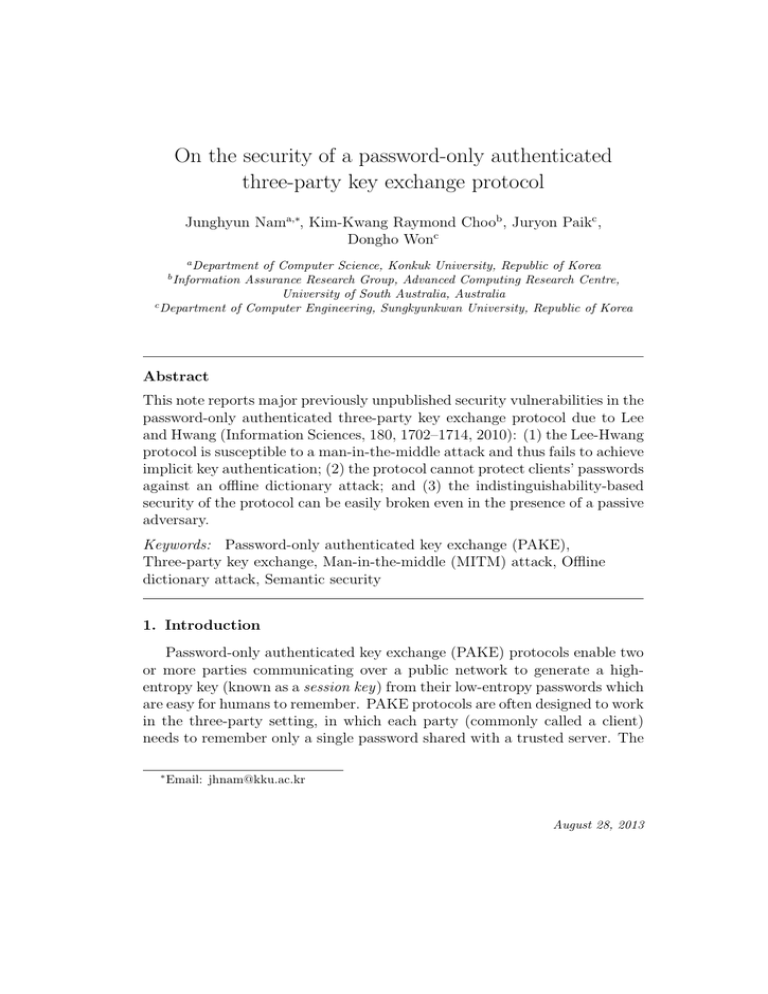On the security of a password-only authenticated three
advertisement

On the security of a password-only authenticated three-party key exchange protocol Junghyun Nama,∗, Kim-Kwang Raymond Choob , Juryon Paikc , Dongho Wonc a Department of Computer Science, Konkuk University, Republic of Korea Information Assurance Research Group, Advanced Computing Research Centre, University of South Australia, Australia c Department of Computer Engineering, Sungkyunkwan University, Republic of Korea b Abstract This note reports major previously unpublished security vulnerabilities in the password-only authenticated three-party key exchange protocol due to Lee and Hwang (Information Sciences, 180, 1702–1714, 2010): (1) the Lee-Hwang protocol is susceptible to a man-in-the-middle attack and thus fails to achieve implicit key authentication; (2) the protocol cannot protect clients’ passwords against an offline dictionary attack; and (3) the indistinguishability-based security of the protocol can be easily broken even in the presence of a passive adversary. Keywords: Password-only authenticated key exchange (PAKE), Three-party key exchange, Man-in-the-middle (MITM) attack, Offline dictionary attack, Semantic security 1. Introduction Password-only authenticated key exchange (PAKE) protocols enable two or more parties communicating over a public network to generate a highentropy key (known as a session key) from their low-entropy passwords which are easy for humans to remember. PAKE protocols are often designed to work in the three-party setting, in which each party (commonly called a client) needs to remember only a single password shared with a trusted server. The ∗ Email: jhnam@kku.ac.kr August 28, 2013 design of secure yet efficient three-party PAKE protocols is notoriously hard and continues to be a subject of active research. A key challenge in designing such protocols is to prevent potential attacks by a malicious client, who is registered with the server and thus is able to set up normal protocol sessions with other clients. The brief contribution of this note is to present previously unpublished flaws in the S-EA-3PAKE protocol, a three-party PAKE protocol proposed by Lee and Hwang [4]. The design of the S-EA-3PAKE protocol is relatively simple and efficient, and carries a claimed proof of security in the ROR model due to Abdalla, Fouque and Pointcheval [1]. However, despite the claim of provable security, this protocol exhibits major security weaknesses. First, the protocol fails to achieve implicit key authentication, which is the fundamental security property that any given key exchange protocol is expected to provide. We demonstrate this by mounting a man-in-the-middle attack against the protocol. The attacker could be any malicious client. Second, the protocol is vulnerable to an offline dictionary attack by a malicious client and thus other clients cannot be guaranteed of the security of their passwords. Third, the protocol does not achieve semantic security of session keys; that is, session keys established by S-EA-3PAKE are distinguishable from random keys. We show this by mounting a passive attack in the ROR model, thereby invalidating the existing proof of security for S-EA-3PAKE. 2. The S-EA-3PAKE protocol The S-EA-3PAKE protocol [4] is built upon Abdalla and Pointcheval’s 2party PAKE protocol called SPAKE [2]. Let A and B be two clients who wish to establish a session key, and pwA and pwB denote the passwords of A and B, respectively, shared with a trusted server S. The public parameters required by S-EA-3PAKE include: (1) a large prime p and a generator g of Z∗p , (2) two random elements M and N of Z∗p , (3) a cryptographic hash function H used as a key derivation function, and (4) a pair of message authentication code (MAC) generation/verification algorithms (Mac, Ver), where Ver outputs a bit, with 1 meaning accept and 0 meaning reject. S-EA-3PAKE proceeds as follows: Step 1. A sends S and B a protocol initiation message Minit = ⟨A, B⟩ which states “A wants to establish a session key with B”. 2 Table 1: Establishing the secret keys kAS and kBS pwA → kAS pwB → kBS A chooses a random x ∈ Z∗p , computes X = g x and X ∗ = X ·M pwA , and sends X ∗ to S. At the same time, S chooses a random u ∈ Z∗p , computes U = g u and U ∗ = U · N pwA , and sends U ∗ to A. Then, A and S set kAS = g xu . B chooses a random y ∈ Z∗p , computes Y = g y and Y ∗ = Y · M pwB , and sends Y ∗ to S. At the same time, S chooses a random v ∈ Z∗p , computes V = g v and V ∗ = V · N pwB , and sends V ∗ to B. Then, B and S set kBS = g yv . Step 2. A and S establish a shared secret key kAS by running the 2-party protocol SPAKE. Likewise, B and S establish a shared secret key kBS . More precisely, kAS and kBS are established as shown in Table 1. Step 3. A (resp. B) computes the authenticator σAS = MackAS (A∥S) (resp. σBS = MackBS (B∥S)) and sends it to S. Step 4. S aborts if either VerkAS (A∥S, σAS ) = 1 or VerkBS (B∥S, σBS ) = 1 is untrue. Otherwise, S selects a random s ∈ Z∗p , computes σSA ∗ X = X s, Y = Y s, ∗ ∗ X = Y · kAS , Y = X · kBS , = MackAS (S∥A), σSB = MackBS (S∥B), ∗ and sends ⟨X , σSA ⟩ and ⟨Y , σSB ⟩ to A and B, respectively. Step 5. A checks if VerkAS (S∥A, σSA ) = 1, and aborts if the check fails. ∗ Otherwise, A computes the key derivation secret, KA = (X /kAS )x , and the session key, skA = H(A∥B∥KA ). Meanwhile, B checks if VerkBS (S∥B, σSB ) = 1, and aborts if the check fails. Otherwise, B ∗ computes KB = (Y /kBS )y and skB = H(A∥B∥KB ). Step 6. A and B perform key confirmation by exchanging σAB = MacskA (A∥ B) and σBA = MacskB (B∥A) and verifying them in a straightforward way. The correctness of S-EA-3PAKE can be easily verified from KA = KB = g xys . 3 3. Previously unpublished flaws 3.1. No implicit key authentication Implicit key authentication of S-EA-3PAKE can be violated via a manin-the-middle attack by a malicious (registered) client C. A possible attack scenario is as follows: 1. The attacker C blocks the protocol initiation message Minit = ⟨A, B⟩ from reaching S and instead, sends (to S) two forged initiation messages ′ ′′ Minit = ⟨A, C⟩ and Minit = ⟨C, B⟩ which state, respectively, “A wants to establish a session key with C” and “C wants to establish a session key with B”. As a result, S will think that there are two protocol sessions running concurrently; let ΠA,C denote the session between A and C and ΠC,B denote the session between C and B. 2. In both the sessions ΠA,C and ΠC,B , C performs Steps 2 through 5 as per the protocol specification with its true identity. This can go undetected since none of the authenticators, σAS σBS , σSA and σSB , can confirm who the actual protocol participants are. As a result, C will share a session key, skA,C , with A and another session key, skC,B , with B. 3. With skA,C and skC,B in hand, C can perform Step 6 (of both sessions) in the straightforward way without being detected; C simply replaces σAB = MacskA,C (A∥B) and σBA = MacskC,B (B∥A), respectively, with ′ ′ σAB = MacskC,B (A∥B) and σBA = MacskA,C (B∥A). At the end of the attack scenario, A and B believe that they have established a secure session with each other sharing a key, while in fact they have shared their keys with the attacker C. Consequently, S-EA-3PAKE fails to achieve implicit key authentication. 3.2. No password security We now show that S-EA-3PAKE cannot protect clients’ passwords against an offline dictionary attack. Assume a malicious client C who wants to find out the passwords of A and B. Let pwC be the password of C. Then, an offline dictionary attack by C against both A and B can be mounted as follows: Phase 1 (Gathering Password Verifiers Online). C conducts a type of man-in-the-middle attack to obtain information required to verify password guesses. 4 1. C blocks the initiation message Minit = ⟨A, B⟩ from reaching S ′ and instead, sends two forged initiation messages Minit = ⟨A, C⟩ ′′ and Minit = ⟨C, B⟩, thereby deceiving S into thinking that there are two protocol sessions, ΠA,C and ΠC,B , running concurrently. 2. C then performs Steps 2 through 5 of both sessions as specified by the protocol except for the following: • When A and B send X ∗ = X · M pwA and Y ∗ = Y · M pwB in Step 2, C makes a copy of these messages for later use. • C sends the same Step 2 message Z ∗ = g z · M pwC of its own for both sessions, where z ∈R Z∗p . ∗ ∗ • When S sends ⟨X , σSA ⟩ and ⟨Y , σSB ⟩, respectively, to A ∗ ∗ and B in Step 4 of the sessions, C replaces X and Y with ∗ ∗ b ∗ = X · g z and Yb ∗ = Y · g z , respectively. X ∗ ∗ ′ Let ⟨Z , σSC ⟩ and ⟨Z ′ , σSC ⟩ denote the two messages sent by S to C in Step 4 of ΠA,C and ΠC,B , respectively. 3. Now when A and B exchange the key confirmation messages σAB = MacskA (A∥B) and σBA = MacskB (B∥A), C intercepts these messages and instead, sends the clients ‘a failure message’ to trick them into believing that due to an unexpected error, their partner has failed to compute the session key and thus has aborted the protocol. Phase 2 (Verifying Password Guesses Offline). C can now verify password guesses both on pwA and pwB using the obtained information ∗ ∗ (X ∗ , Z , σAB ) and (Y ∗ , Z ′ , σBA ), respectively. (For simplicity, we here describe this verification phase only for pwA ; the case for pwB proceeds correspondingly.) Step 1. C computes ( Z ∗ )z KC = kCS z =X = g xzs , where kCS is the secret key shared between C and S in Step 2 of session ΠA,C . 5 ∗ b ∗ = X ∗ · g z , A must Step 2. Note that since X was replaced with X have computed KA as KA = = (X b ∗ )x kAS ( X ∗ · g z )x kAS = (g · g z )x = g xzs · g xz . zs ′ With this in mind, C makes a guess pwA on the password pwA and computes X′ KA′ skA′ ′ σAB = = = = ′ X ∗ /M pwA , z KC · X ′ , H(A∥B∥KA′ ), MacskA′ (A∥B). ′ Step 3. A verifies the correctness of pwA by checking that σAB is equal ′ ′ to σAB . If they are equal, then pwA is the correct password with an overwhelming probability. Step 4. C repeats Steps 2 & 3 (of this verification phase) until a correct password is found. This offline dictionary attack can be trivially simplified to an insider-attacker version whereby one of the two clients, A and B, tries to discover the other client’s password. After all, the S-EA-3PAKE protocol cannot prevent any (malicious) client from mounting an offline dictionary attack against any other client. 3.3. No semantic security Finally, we point out that the S-EA-3PAKE protocol does not achieve the semantic security of session keys. In S-EA-3PAKE, the session key skA (resp. skB ) is used as the MAC key in generating the authenticator σAB = MacskA (A∥B) (resp. σBA = MacskB (B∥A)). This oversight leaks some information about the session key and allows an adversary to distinguish the real session key from a random key chosen from the session-key 6 space. Indeed, S-EA-3PAKE can be easily broken even in the presence of a passive adversary who asks only a single Execute and Test query. A simple attack by such an adversary A can be described as follows: 1. First, A makes an Execute(Π∗A , Π∗B , Π∗S ) query, where Π∗A , Π∗B and Π∗S denote any instance of A, B and S, respectively. This query prompts an honest execution of the protocol between the three instances and will return the transcript of the protocol execution. 2. Next, A makes a Test(Π∗A ) query and receives a key sk in response to the query. ′ ′ 3. Then, A computes σAB = Macsk (A∥B) and checks if σAB is equal to σAB . The key sk is real if they are equal and otherwise, it is random. This attack invalidates the existing proof of security for S-EA-3PAKE [4]. We refer the reader to the work of Bellare, Pointcheval and Rogaway [3] for a possible countermeasure. 4. Concluding remarks The model where S-EA-3PAKE was claimed to be provably secure does not allow the adversary to ask Corrupt queries and thus cannot capture any kind of attacks that can be mounted by malicious clients. Accordingly, neither the man-in-the-middle attack nor the offline dictionary attack described above can be captured in the proof model. This situation is clearly unacceptable, from both theoretic and practical perspectives, and highlights the importance of considering Corrupt queries when proving security of threeparty PAKE protocols. Although both the man-in-the-middle attack and the dictionary attack can be easily prevented by modifying the computations of ∗ ∗ σSA and σSB to σSA = MackAS (S∥X ∥A∥B) and σSB = MackBS (S∥Y ∥B∥A), the existence of a security proof for the S-EA-3PAKE protocol in a stronger model remains an open question. We finally note that all the three attacks presented in this note against S-EA-3PAKE also apply to the S-IA-3PAKE protocol [4], a simplified variant of S-EA-3PAKE. This becomes clear as soon as we notice that S-IA-3PAKE is different from S-EA-3PAKE only in that it does not require the transmission of the authenticators σAS σBS , σSA and σSB . 7 References [1] M. Abdalla, P. Fouque, D. Pointcheval, Password-based authenticated key exchange in the three-party setting, In Proceedings of PKC 2005, LNCS 3386: 65–84, 2005. [2] M. Abdalla, D. Pointcheval, Simple password-based encrypted key exchange protocols, In Proceedings of CT-RSA 2005, LNCS 3376: 191– 208, 2005. [3] M. Bellare, D. Pointcheval, P. Rogaway, Authenticated key exchange secure against dictionary attacks, In Proceedings of EUROCRYPT 2000, LNCS 1807: 139–155, 2000. [4] T. Lee, T. Hwang, Simple password-based three-party authenticated key exchange without server public keys, Information Sciences 180(9): 1702–1714, 2010. 8



